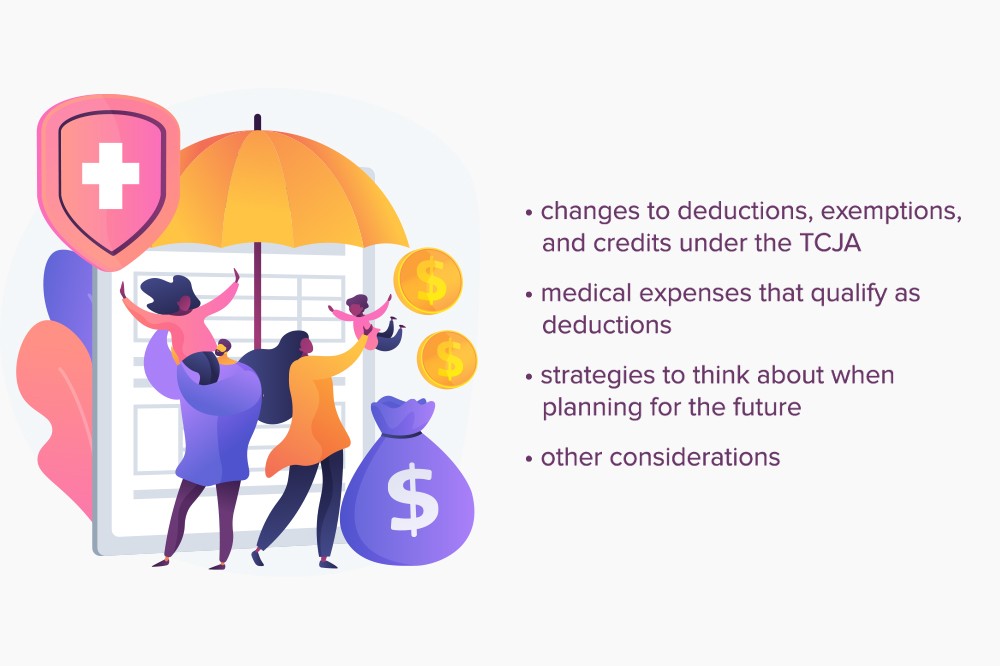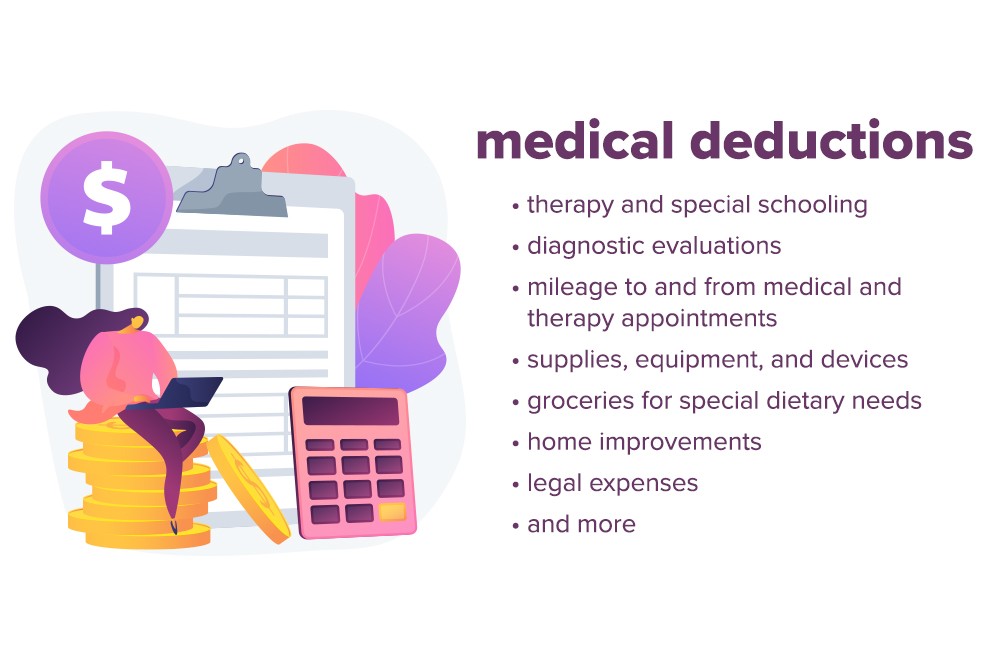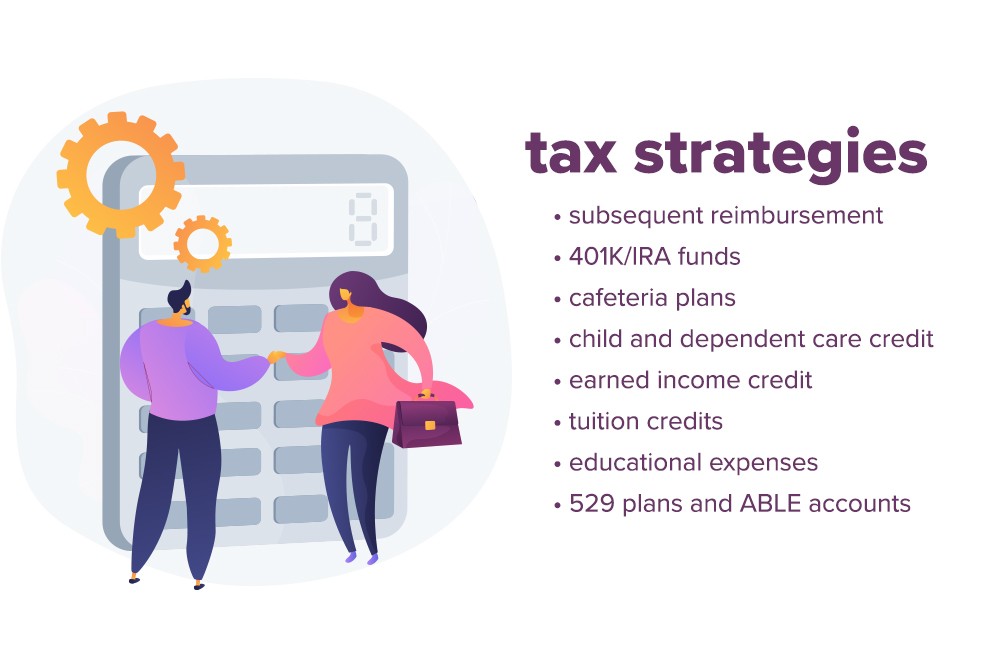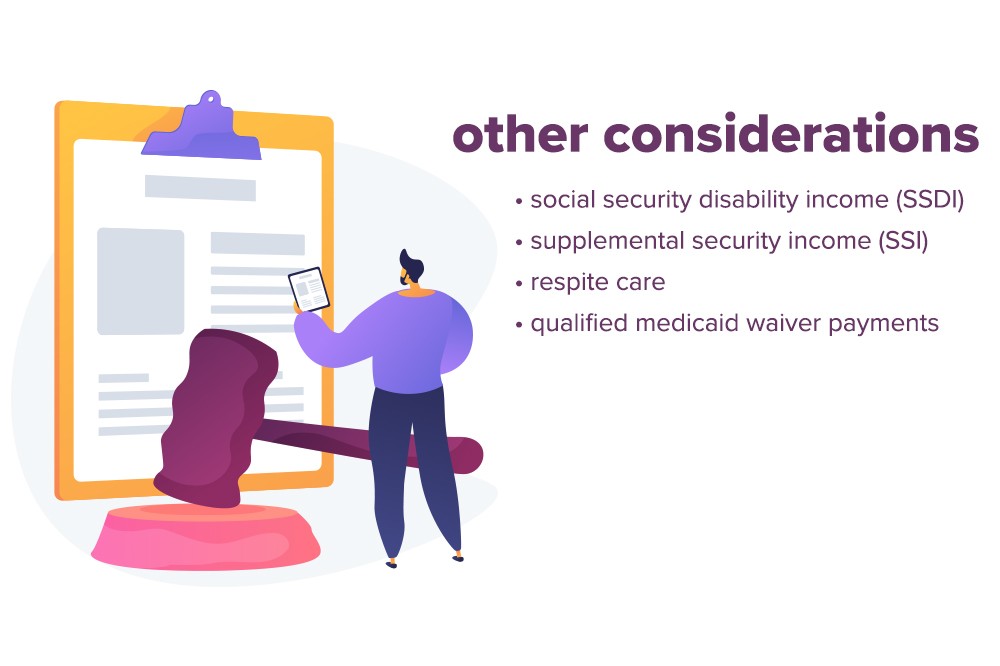Tax Strategies for Parents of Kids with Special Needs

All contents of this resource were created for informational purposes only and are not intended to be a substitute for professional advice, diagnosis, or treatment. Always seek the advice of your physician, therapist, or other qualified health providers with any questions or concerns you may have.

Regina M. Levy, CPA
If you’re the parent of a child with special needs, there are some tax strategies to be aware of that can save your family money. For example, you can deduct the cost of many out-of-pocket expenses on your federal taxes. In this article, you’ll learn about deductions as well as other strategic considerations such as tax credits.
Updated January 18, 2024 by Regina M. Levy, CPA
Please note: The information in this article is educational in nature and is not to be considered tax advice. Please contact a qualified tax professional to discuss how these concepts may or may not apply to your personal situation.
Summary of Tax Cuts and Jobs Act (TCJA) as It Relates to Families
Before we go into details about deductions and other tax strategies, let’s talk about the Tax Cuts and Jobs Act (TCJA) as it relates to families. The TCJA is the big tax reform bill that passed at the end of 2017. It is important to be aware of the TCJA because it not only changed tax rates and brackets, but also included other changes that significantly affect families, such as:
1. Increased Standard Deduction and Made Changes to Itemized Deductions
- Fewer families will itemize (file Federal Schedule A) because the standard deduction has increased:
- $13,850 for Single,
- $20,800 for Head of Household,
- and $27,700 for Married Filing Jointly.
- In addition, many deductions allowed in prior years have been either limited or eliminated. For example:
- The deduction for state and local taxes, i.e. income, property, DMV fees, etc., is capped at $10,000.
- Casualty losses are restricted to Federally Declared Disaster Areas.
- Miscellaneous Itemized Deductions, which included expenses like safety deposit box fees, tax preparation fees, investment advice, uniforms, union dues, and job search costs, are no longer permitted.
- Families in California: because California has not conformed to any of the changes to Itemized Deductions, I expect that many California families will be taking the Standard Deduction for Federal and Itemizing for State tax purposes.
- Families outside of California: look at your State’s income tax agency’s website to check if your State has conformed or not. This means that the record keeping required for tax purposes has not changed.
2. Elimination of Personal Exemptions
- Personal exemptions have been eliminated.
- However, you will still need to identify your dependents on your return to claim such benefits as Head of Household status, Child Tax Credit, Earned Income Tax Credit or Educational Credits.
3. Expanded Child Tax Credit
- The Child Tax Credit has been increased and expanded. The credit is now $2,000 per child.
- Out of the $2,000, $1,600 is refundable, meaning it will be paid out even if there is no tax liability.
- Almost all families will now qualify, as this credit does not begin to phase out until AGI exceeds $400,000 for a married couple and $200,000 for all others.
- For the purpose of this credit, the age limit for a qualifying child is under age 17 at the end of the tax year.
4. Credit for Other Dependents
- There is a $500 credit for dependents of any age, including those who are age 18 or older
- You cannot use the dependent to claim the child tax credit or additional child tax credit.
- Dependent must meet certain conditions to qualify.
- The credit begins to phase out when AGI exceeds $400,000 for a married couple and $200,000 for all others.
- This category would include household members who are permanently disabled.
Medical Deductions

Now that you understand the TCJA’s impact on families, let’s talk about medical deductions. Section 213 of the IRS code allows a deduction for “expenses paid during the taxable year, not compensated for by insurance or otherwise, for medical care of the taxpayer, his spouse, or a dependent.”
The term ‘medical care’, as used in this subsection, shall include amounts paid “for the diagnosis, cure, mitigation, treatment, or prevention of disease, or for the purpose of affecting any structure or function of the body.”
This is a pretty broad definition of medical care. The IRS code, refined by both revenue rulings and tax court cases, includes both mental and physical functions in the phrase ‘any structure or function of the body.’
Accordingly, medical care can include tutoring and special schooling for learning disabilities, but it does not include things like elective plastic surgery for purely aesthetic reasons. In certain specific circumstances, legal fees can qualify as a medical deduction if they were incurred to access medical care.
In short, you can deduct qualified, non-reimbursed medical expenses as long as they total up to more than 7.5% of your Adjusted Gross Income (AGI). Below are examples of expenses that qualify as a medical deduction.
Read the IRS website FAQ section on Medical Expenses
Deductible Educational and Therapeutic Expenses:
- Special Schooling including tuition or tutoring by someone specially trained to meet the child’s needs.
- Specifically, the purpose and primary reason for the choice of school must be to alleviate or remediate the disability.
- For example, you can deduct the tuition for a typical preschool education as long as the primary purpose for enrollment is to help remediate social skill deficits (resulting from a disability/developmental delay) rather than education.
- Aides required for a child to benefit from regular or special education.
- Special instruction, training or therapy such as OT, Speech, remedial reading, etc.
- Diagnostic evaluations by qualified personnel.
- Certain genetic testing can be deductible (must be related to a medical condition).
- Exercise program if recommended and monitored by qualified medical personnel to treat a specific condition, includes yoga, dance, horseback riding, etc.
- The IRS recognizes obesity as a disease; therefore, any payments made for participating in a weight loss program are deductible as medical care if directed by a physician.
- Parents’ attendance at a disability related conference. This good news came in May 2000, in IRS Revenue Ruling 2000-24.
- Attendance is considered to be primarily for and essential to the care of the dependent if:
- Attendance at the conference has been recommended by a medical provider treating the child, AND
- The conference provides medical information concerning the child’s condition – specific issues not just general well being, AND
- The primary purpose of the visit is to attend the conference.
- Parents who attend conferences primarily to obtain medical information concerning treatment for and care of their child may include the following admission and transpiration costs.
- Related books and materials are deductible.
- BUT … Costs of food and lodging are generally NOT deductible.
- Attendance is considered to be primarily for and essential to the care of the dependent if:
Deductible Expenses for Supplies/Equipment:
The cost of equipment, supplies, or devices is deductible as long as their primary use is for alleviating a person’s illness or disability. For example, you can deduct:
- Diapers – if toilet training is delayed due to a medical condition.
- Specially designed bedding, car seats, etc.
- For more examples, please see Rev Ruling 76-80.
Deductible Expenses for Special Diets:
Many people are unaware that the extra costs incurred from following a specially prepared medical diet, like the gluten-free, casein-free diet, can qualify as medical expenses. On March 24, 2011, the IRS Chief Counsel’s office issued a letter to clarify this issue:
“Specifically, the excess cost of specially prepared foods designed to treat a medical condition over the cost of ordinary foods which would have been consumed but for the condition is an expense for medical care…. Therefore, if a taxpayer can establish the medical purpose of the diet, such as through a physician’s diagnosis, then to the extent the cost of the food for the special diet exceeds the cost of the food that satisfies a taxpayer’s normal nutritional needs if the special diet were not required, the excess cost is an expense for medical care under section 213(d).”
When deducting expenses for special diets, please consider the following tips:
- Save all cash register tapes, credit card receipts, and canceled checks to substantiate your gluten-free and or casein-free purchases.
- You will need to prepare a list of typical foods at typical grocery store prices to arrive at the differences in costs.
- However, specific products used only for a gluten-free diet such as xanthan gum are 100% deductible.
- Here is an example of a GFCF Diet Deductible Worksheet.
- You need not submit your documentation or computations with your return, but do retain them with your other tax records.
- You can also claim mileage expense for the trip to the health food store and postal costs on gluten-free products ordered by mail.
- Most importantly,attach a letter from your doctor to your tax return that states your child suffers from a medical condition which requires a special diet.
Deductible Travel Expenses:
- Mileage to and from special schools or therapy sessions. Also, parking fees.
- Mileage to and from health food stores to obtain groceries for special dietary needs.
- Airfare for parents and child to obtain treatment or testing.
- The 2023 medical mileage rate is set at 22 cents per mile driven.
- Lodging required to obtain medical treatment, limited to $50 per night, per person. Meals during medical travel are not deductible.
Deductible Costs for Home Improvements:
- Costs are deductible to the extent they exceed any increase in the home’s fair market value [Reg. 1.213-1(e) (1) (iii)].
- Certain improvements (e.g., altering the location of or otherwise modifying electrical outlets and fixtures are deemed to have no affect on the home’s fair market value and thus, the full cost can be claimed as a medical expense [Rev. Rul. 87-106, 1987-2 CB 67].
- Lead Paint Removal: the cost of removing the paint can be deductible if the child has lead poisoning from the paint. Lead poisoning can resemble and complicate other conditions, such as autism.
Deductible Legal Expenses:
Legal expenses incident to medical care have been allowed as a medical expense deduction only when the legal expenses are “necessary to legitimate a method of medical treatment” Levine v. Commissioner [83-1 USTC ¶9101].
This means that attendance at IEP meetings is not a deductible legal or medical expense. However, if you have to engage a lawyer to enforce an IEP or IFSP, that may be deductible, especially if you are suing the school to hire appropriate personnel.
Is Cannabis Considered a Medical Expense?
Many people ask me about medical use of Cannabis. Unfortunately, because the Federal Government still considers this a controlled substance, it is not a deductible medical expense for either Federal or California purposes. California law as it relates to medical expenses conforms to Federal law. Therefore, even though the use of medical Cannabis is legal in California, the deduction is not permitted.
Tax Strategies

Considerations
Subsequent Reimbursement
If you anticipate reimbursement from a school district or insurance company for any of these costs, that reimbursement will be includable as income when received if the deductions are taken. That could raise your AGI in the subsequent year causing you to lose other deductions. Deciding when or if to take deductions is an important reason to see a qualified tax professional.
401K/IRA Funds
Medical expense, it can also be used to justify a “hardship” withdrawal from a 401(k) retirement plan [Reg. 1.401(k (-1(d) (3) (iii) (B)]. However, the amount not subject to the additional 10% tax penalty is only the amount over 10% of AGI. Regular tax must still be paid on all IRA/401K withdrawals. Generally withdrawing retirement funds is not a good idea due to increased taxes and penalties.
On December 19, 2019, an appropriations bill was passed repealing the maximum age for IRA contributions. You can also now count IHSS income as qualifying for the purpose of making retirement contributions.
Cafeteria Plans
If your employer offers a cafeteria plan; you can use the funds in that account to pay for treatments for your child. Such an account can cover all the items listed above under medical expenses, including schooling, tutoring, therapy, conferences, etc. Tax-wise this is the most advantageous option as you are paying for these items with pre-tax dollars and are not subject to the 10% limitation. But, the Affordable Care Act limits the annual contribution to $2,500.
Credits
Even better than deductions, credits reduce $ for $ the amount of tax owed.
Child and Dependent Care Credit
Covers work related expenses for dependents of taxpayer. Dependent must be under the age of 13. If the child requires supervision due to a disability, the age limit no longer applies. A dependent is considered to be physically or mentally incapable of self-care if the dependent is incapable of caring for his or her hygienic or nutritional needs, or requires full-time attention of another person for his or her own safety or the safety of others [Reg 1.44A-1(b)(4)].
Covered expenses – up to $3,000 per year per dependent are allowed, max for all dependents is $6,000. Amount does not need to be equal among children. Regular childcare, after-school programs and day camp qualify. Sleep-away camps do not. Credit is calculated at 20-35 percent of expenses, based on AGI. The maximum credit per dependent is $600 for one child, $1,200 for 2 or more.
Planning strategy – use the first $3,000-$5,999 of special schooling costs to claim this credit; any remaining costs can be deducted as medical expenses. At least $1 must be for the other child to claim more than $3,000.
Earned Income Credit
Families with AGIs under $63,398 may qualify for EIC (Earned Income Credit) depending on number of children and filing status. The EIC typically applies to children under the age of 19. If the child is 19-23 and a full-time student, then he or she also qualifies. As long as a severely disabled child lives with his or her parent, there is no age limit for EIC.
IHSS can now be used as ‘earned income’ to qualify for the EIC, even if you have excluded IHSS wages from Gross Income. In other words, you can claim the credit without paying taxes on the income. This is new as of 2020. Please consult a tax professional if you have questions regarding this.
Higher Education
Tuition Credits
American Opportunity Credit is up to $2,500 per student, per year for first 4 years of post-secondary education. The credit can be up to 40% refundable. The student must be pursuing an undergraduate degree or other recognized educational credential, enrolled more than 1/2 time, and have no felony drug convictions.
The Lifetime Learning Credit is a maximum of $2,000 per return, for all post-secondary education and courses to acquire or improve job skills, unlimited number of years, no degree required. Unlike the American Opportunity Credit, the felony drug conviction rule does not apply. The credit is computed as 20% of first $10,000 = $2,000.
However, there are limitations based on AGI. These benefits begin to phase out for higher income taxpayers at the lower number and are eliminated when AGI reaches the upper number.
American Opportunity Credit – $160,000 – $180,000
Lifetime Learning Credit – $100,000 – $120,000
Educational Expenses
Educational expenses may also be taken as a deduction. Tax return preparation programs generally maximize either credit or deduction. Maximum deductions are as follows:
- $4,000 – AGI < $130,000
- $2,000 – AGI < $160,000
- None if AGI > $160,000
529 Plans and ABLE Accounts
Contributions to a 529 College Savings Plan grow tax free until a child uses the funds. Proper planning can maximize the use of educational credits, scholarship funds, and withdrawals from 529 plans.
TCJA allows parents to use up to $10,000 tax free distributions from a 529 plan for elementary or secondary education in a private school setting (k-12). The $10,000 limit applies per student, not per 529 account, and it can only be used for tuition.
Distributions from 529 accounts for post-secondary education (college or vocational) can be used for education related expenses in addition to tuition, such as:
- Computers, peripheral equipment, software
- Internet access
- Special needs services in connection with enrollment or attendance
- Fees, books, supplies, and equipment required for attendance.
California does not conform to the use of 529 funds for K-12 but does conform to all postsecondary uses.
Any distribution from 529 account is first applied to principal then to earnings. Also, if a student drops a class and receives a tuition refund, the redeposit of that tuition into a 529 plan is considered a recontribution of principal, even if the original distribution had included earnings. California does conform to this change.
You may roll over funds from a 529 account into an ABLE account tax-free for Federal tax purposes. The annual limit of such a rollover is $15,000 for 2018 and 2019. California does not conform to this change, and any earnings included in the rollover will be subject to a 2.5% penalty and includable in taxable income.
Proper planning can maximize the use of educational credits, scholarship funds, and withdrawals from 529 plans.
Important Limitation: If filing as Married Filing Separately, neither the education credits nor tuition and fees deductions apply. Also interest on student loans is not deductible.
Other Matters

Social Security Disability Income (SSDI) and Supplemental Security Income (SSI) are both programs that provide monthly income to disabled persons. The similarities end there.
SSDI – Social Security Disability Income
This is benefit program that one qualifies for based upon age and work credits. Work credits means that you are insured under FICA, that you paid in FICA taxes during the quarters when you were employed. For tax purposes, it is not distinguishable from regular Social Security Income and is includable in gross income. A Taxpayer attempted to exclude these benefits as “Disability” income under IRC 104(a). The Tax Court disagreed (Palsgaard and Kelly v. Comm, TCM 2018-82).
SSI – Supplemental Security Income
This is a means tested program. You do not have to have earned work credits. For tax purposes, this is not taxable to the recipient because it meets the definition of the General Welfare Exception (GWE). Government funds must be used for GWE payments, which should be based on individual or family need and not serve as payment for services.
However, if a family member is contributing SSI or SSDI payments to cover their share of household expenses, such payments may be taxable income to other family members or may affect the ability to claim Head of Household status. We urge you to contact a qualified tax professional if you have any concerns about the treatment of SSI income.
IHSS Services (California Residents Only)
Respite Care
If you are a parent provider of respite care, you may receive a 1099 from the Regional Center. Attach a statement to your return showing the amount received, and the amounts paid to others, include any net amount on line 21 (other income) of your form 1040. If you paid more than $600 to any other provider, you should provide them with a 1099. If you paid household employees, there are additional payroll forms and taxes that if not filed can result in significant penalties, another reason to consult a qualified tax professional.
Qualified Medicaid Waiver Payments
If you’re a California resident looking for information about qualified Medicaid Waiver Payments not subject to federal taxes, please click here.




